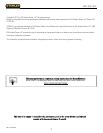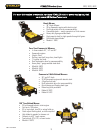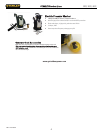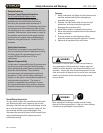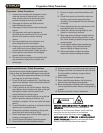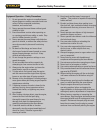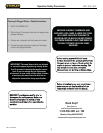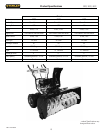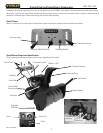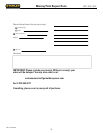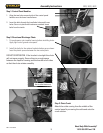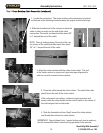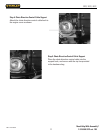
2
30SS, 36SS, 45SS
Rev: 12/21/2011
Preparation Safety Precautions
Preparation—Safety Precautions
1. Inspect the area where the equipment is to be
used and remove all objects such as rocks,
mats, and wire which can be thrown by the
machine causing serious injury or death.
2. Disengage all clutches and shift to neutral
before starting the engine.
3. Disengage all control levers before starting the
engine.
4. Use extension cords and receptacles as
specified by the manufacturer for all units with
electric drive motors or electric starting
motors.
5. Use a grounded three-wire extension cord
when using the electric start option.
6. People, pets, and most importantly children
must not be near the area being cleared. Do
not operate the snow blower in their presence.
7. Never operate snow blower with damaged
guards, shields or covers.
8. All users of the snow blower must be alert and
pay attention to safety alerts, symbols, and
safety signs.
9. Be sure to inspect snow blower before each
use.
10. Check the controls and shields to make sure
that they are functioning properly before
operating. Do not operate if any are damaged
or missing.
11. Never attempt to make any adjustments to the
snow blower while it is running.
12. Adjust the collector housing height to clear
gravel or crushed rock surfaces.
13. Wear appropriate clothing including hard hat,
safety glasses and hearing protection. Long
hair, loose clothing or jewelry may get tangled
in moving parts.
14. Do not operate without wearing adequate
winter clothing. Wear footwear that will
improve footing on slippery surfaces.
15. Allow snow blower to adjust to outdoor
temperature before starting the engine.
DANGER: GASOLINE IS HIGHLY FLAMMABLE AND
EXPLOSIVE.
Do not add fuel while the engine is
running or is hot. Keep open flames, sparks, and heat
away from the fuel and store fuel in containers
specifically designed for that purpose. A
ADD FUEL
OUTDOORS ONLY. IF THE FUEL IS SPILLED, DO NOT
START THE ENGINE.
Manually push the snow blower
away from the spill and wipe up immediately.
DANGER
Gasoline and other fuels—Safety Precautions
Use extra care when handling gasoline and other
fuels as they are flammable and vapors can explode.
1. Only use gasoline approved containers for storage
and keep out of reach from children.
2. Do not fill fuel tank completely full. Overfilling may
result in fuel leakage. Leave a reasonable amount
of space for fuel to expand.
3. If fuel is spilled, do not start the engine. Move the
snow blower away from the area, wipe up the spill
thoroughly and wait until fuel vapors have
evaporated before starting engine.
4. Keep the nozzle in contact with the rim on the fuel
tank or container opening at all times, until
refueling is complete. Do not use nozzle lock-open
device.
5. Do not fill gasoline containers or equipment inside a
vehicle or on a truck/trailer bed.
6. Always place gasoline containers on the ground
away from your vehicles prior to filling.
7. Never remove gas cap or add fuel when engine is
running or the engine is hot.
8. Avoid prolonged breathing of gasoline vapors.
9. Never refuel or drain the machine indoors.
10. Keep face away from nozzle and gas tank opening.
11. Keep gas and other fuels away from skin and eyes.
If fuel is spilled on clothing, change clothing
immediately.
12. Never use the mouth to siphon gas.
13. Never refuel the snow blower until all moving
parts on the snow blower have stopped.
14. Never smoke when handling fuels and stay away
from an open flame where fumes can be ignited by
a spark.
15. Gasoline is harmful or fatal if swallowed.




